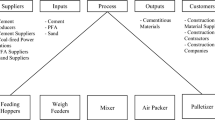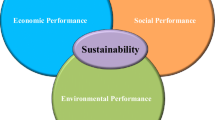Abstract
This study presents a compound approach with a five-phase process to assess and improve the green performance. Based on the Six Sigma approach, the five-phase process consists of definition, measurement, analysis, improvement and control (DMAIC) phases. During the first three phases, an evaluation the assessment model is developed based on the analytical hierarchy process. Particle swarm optimization is also performed to search for the sequence of actions in order to improve the green performance based on the output of the assessment model. Managers can monitor the progress of the improvement plan during the control phase. A case study involving two global footwear manufacturers demonstrate the effectiveness of the proposed approach.





Similar content being viewed by others
References
Adbel-Maksoud A (2004) Manufacturing in the UK: contemporary characteristics and performance indicators. J Manuf Technol Manag 15(2):155–171
Asian Productivity Organization (2011) Eco-products directory 2011. Asian Productivity Organization, Japan
Awasthi A, Chauhan SS, Goyal SK (2010) A fuzzy multicriteria approach for evaluating environmental performance of suppliers. Int J Prod Econ 126(2):370–378
Baumgarten H, Klinkner R, Sommer-Dittrich T (2004) Reconfigurable logistics systems in production and disassembly networks. Int J Prod Res 42(17):3647–3655
Bertolini M, Bottani E, Rizzi A, Bevilacqua M (2007) Lead time reduction through ICT application in the footwear industry: a case study. Int J Prod Econ 110(1–2):198–212
Bilgen B, Sen M (2011) Project selection through fuzzy analytic hierarchy process and a case study on Six Sigma implementation in an automotive industry. Prod Plan Cont 22(2):1–24
Birnie P, Boyle A, Redgwell C (2009) International law and the environment. Oxford University Press, New York
Brito MPD, Carbone V, Blanquart CM (2008) Towards a sustainable fashion retail supply chain in Europe: organization and performance. Int J Prod Econ 114(2):534–553
Chituc CM, Azevedo C, Toscano A (2008) Interoperability in collaborative networks: independent and industry-specific initiatives–the case of the footwear. Comput Ind 59(7):741–751
Christu Paul R, Asokan P, Prabhakar VI (2006) A solution to the facility layout problem having passages and inner structure walls using particle swarm optimization. Int J Adv Manuf Technol 29(7–8):766–771
Chronicle Guidance Publications (2005) Shoe industry workers: brief 142. http://www.spcollege.edu/Central/Career/OCDS/Briefs/Briefs/Brief142.PDF. Accessed 05 August 2011
Chung C, Wee H (2008) Green-component life-cycle value on design and reverse manufacturing in semi-closed supply chain. Int J Prod Econ 113(2):528–545
Curkovic S, Sroufe R (2007) Total quality environmental management and total cost assessment: an exploratory study. Int J Prod Econ 105(2):560–579
de Ron AJ (1998) Sustainable production: the ultimate result of a continuous improvement. Int J Prod Econ 56–57(1):99–110
Desombre ER (2005) The evolution of international environmental cooperation. J Int Law Int Relat 1(1–2):75–88
Dobos I (1999) Production strategies under environmental constraints in an Arrow Karlin model. Int J Prod Econ 59(1–3):337–340
European Commission (2011a) Ecodesign your future. http://ec.europa.eu/enterprise/policies/sustainable-business/ecodesign/files/brochure_ecodesign_en.pdf. Accessed 05 August 05 2011
European Commission (2011b) Recast of the WEEE and RoHS directives. http://ec.europa.eu/environment/waste/rohs_eee/index_en.htm. Accessed 05 August 2011
European Commission (2011c) Registration, evaluation, authorization and restriction of chemicals. http://ec.europa.eu/enterprise/sectors/chemicals/reach/index_en.htm. Accessed 05 August 2011
Fuad-luke A (2002) Eco-design handbook: the sourcebook. Thamas & Hudson Ltd, London
Ghalayini AM, Noble JS, Crowe TJ (1997) An integrated dynamic performance measurement system for improving manufacturing competitiveness. Int J Prod Econ 48(3):204–225
Gonzalez-Torre PL, Adenso-Diaz B, Hakim A (2004) Environmental and reverse logistics policies in European bottling and packaging firms. Int J Prod Econ 88(1):95–104
Haas PM, Keohane RO, Levy MA (1993) Institutions for the earth: sources of effective international environmental protection. Massachusetts Institute of Technology Press, Massachusetts
Hitachi Group (2011) Hitachi group corporate sustainability report 2011. http://www.hitachi.com/csr/csr_images/csr2011e.pdf. Accessed 4 September 2011
Jedlicka W (2009) Packaging sustainability: tools, systems and strategies for innovative, 2nd edn. John Wiley & Sons, Inc., Hoboken, pp 201–203
Kennedy J; Eberhart RC (1995) Particle swarm optimization. In: Proceedings of IEEE international conference on neural networks, IV, pp 1942–1948
Kobayashi H (2005) Strategic evolution of eco-products: a product life cycle planning methodology. Res Eng Design 16(1–2):1–16
Kriwet A, Seliger E, Zussman G (1995) Systematic integration of design-for-recycling into product design. Int J Prod Econ 38(1):15–22
Lima PR, Leite MB, Santiago EQ (2010) Recycled lightweight concrete made from footwear industry waste and CDW. Waste Manage (Oxford) 30(6):1107–1113
Living Green Exposition (2009) What is “living green?”. http://www.livinggreen.org/livinggreen.cfm. Accessed 9 Aug 2011
Mascle C, Zhao HP (2008) Integrating environmental consciousness in product/process development based on life-cycle thinking. Int J Prod Econ 112(1):5–17
Michael I, Jeffery QC (2009) Book review: international law and the environment. Osgoode Hall Law J 47(3):595–607
Minner S (2001) Strategic safety stocks in reverse logistics supply chains. Int J Prod Econ 71(1–3):417–428
Nagel MH (2003) Managing the environmental performance of production facilities in the electronics industry: more than application of the concept of cleaner production. J Cleaner Prod 11(1):11–26
o2-USA/Upper Midwest (2011) The 5Rs of Great Eesign. http://www.o2umw.org/5Rs-GreatDesign.html. Accessed 10 Aug 2011
Paloviita A, Vilma L (2010) Recognizing definitive stakeholders in corporate environmental management. Manag Res Rev 33(4):306–316
Perry M, Sohal AS, Rumpf P (1999) Quick response supply chain alliances in the Australian textiles, clothing and footwear industry. Int J Prod Econ 62(1–2):119–132
Razmi J, Rafiei H, Hashemi M (2009) Designing a decision support system to evaluate and select suppliers using fuzzy analytic network process. Comput Ind Eng 57(4):1282–1290
Reinhardt FL (1998) Environmental product differentiation: implications for corporate strategy. Calif Manag Rev 40(4):43–73
Saaty RW (2003) Decision making in complex environments the analytic hierarchy process. McGraw-Hill, New York
Saaty TL (2005) Theory and applications of the analytic network process. RWS Publications, Pittsburgh
Santiago EQR, Lima PRL, Leite MB, Toledo Filho RD (2009) Mechanical behavior of recycled lightweight concrete using EVA waste and CDW under moderate temperature. IBRACON Struct Mat J 2(3):211–221
Sarkis J (2001) Manufacturing’s role in corporate environmental sustainability. Int J Operat Prod Manag 21(5–6):666–686
Sha DY, Hsu CY (2006) A hybrid particle swarm optimization for job shop scheduling problem. Comput Ind Eng 51:797–808
Sharma A, Iyer GR, Mehrotra A, Krishnan R (2010) Sustainability and business-to-business marketing: a framework and implications. Ind Mark Manag 39(2):330–341
SpecialChem (2007) The role of adhesives in the shoe industry. http://www.specialchem4adhesives.com/resources/articles/article.aspx?id=1943. Accessed 20 Aug 2011
Taiwantrade (2011) Taiwan’s footwear industry walks out a path of its own. http://www.taiwantrade.com.tw/ORG/index.jsp?assocRequestId=mvpfootwear. Accessed 16 August
Tickner JA (1998) ISO 14000: will it deter cleaner production? New solut 8(3):285–304
Toshiba Group (2010) Toshiba Group Environmental Report 2010. http://www.toshiba.co.jp/env/en/report/pdf/env_report10_all.pdf. Accessed 16 August 2011
Tseng CT, Liao CJ (2008) A discrete particle swarm optimization for lot-streaming flowshop scheduling problem. Eur J Oper Res 191(2):360–373
Tyler Miller G (2005) Environmental science: working with the earth, 11th edn. Thomson Brooks Cole, Pacific Grove, pp 2–28
Vachon S, Klassen RD (2008) Environmental management and manufacturing performance: the role of collaboration in the supply chain. Int J Prod Econ 111(2):299–315
Yang CL (2010) Improving supplier performance using a comprehensive scheme. Prod Plan Cont 21(7):653–663
Yurdakul M (2002) Measuring a manufacturing system’s performance using Saaty’s system with feedback approach. Integr Manuf Syst 13(1):25–34
Zhu Q, Sarkis J, Cordeiro JJ, Lai KH (2008) Firm-level correlates of emergent green supply chain management practices in the Chinese context. Omega 36(4):577–591
Author information
Authors and Affiliations
Corresponding author
Rights and permissions
About this article
Cite this article
Chuang, SP. Assessing and improving the green performance using a compound approach. Flex Serv Manuf J 26, 69–91 (2014). https://doi.org/10.1007/s10696-012-9156-1
Published:
Issue Date:
DOI: https://doi.org/10.1007/s10696-012-9156-1




